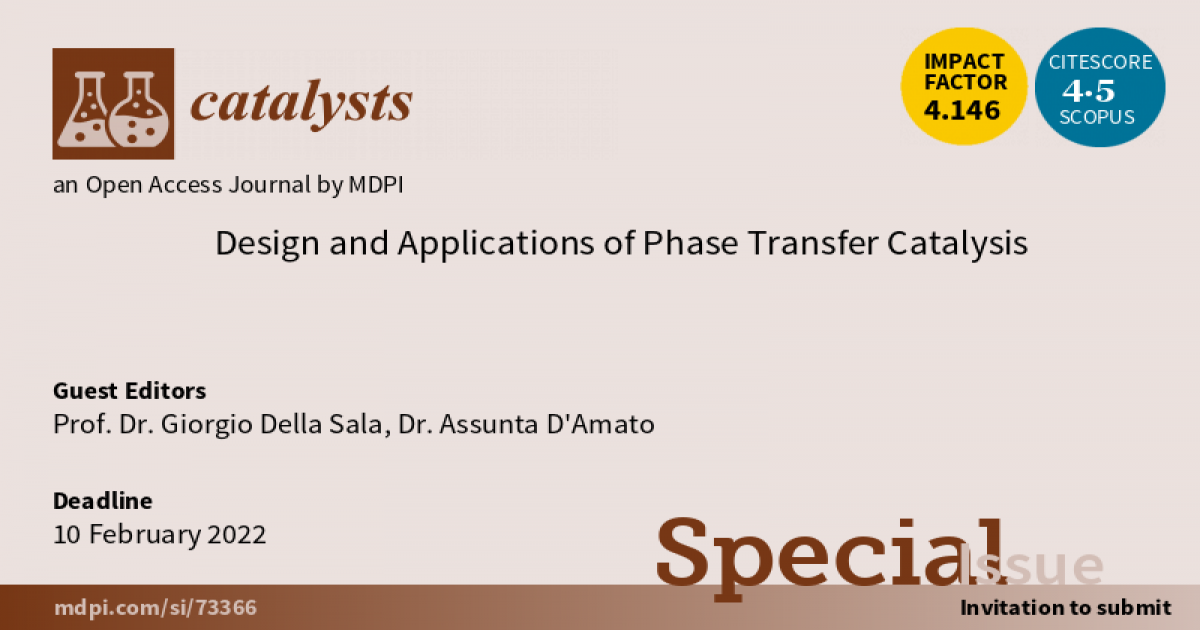- 4.0Impact Factor
- 7.6CiteScore
- 17 daysTime to First Decision
Design and Applications of Phase Transfer Catalysis
This special issue belongs to the section “Catalysis in Organic and Polymer Chemistry“.
Special Issue Information
Dear Colleagues,
Since its first introduction, in the late 1960s, phase transfer catalysis (PTC) has continued to expand its applications in laboratory and industrial processes over the decades. The reasons for this great popularity can be traced back to the operational simplicity and environmental sustainability of this methodology. In fact, PTC combines increased reaction rates in heterogeneous systems, high selectivity, and mild reaction conditions with the employment of non-toxic and recyclable solvents and catalysts. Moreover, phase transfer base-mediated processes are typically conducted with aqueous or solid alkali metal salts such as hydroxides, carbonates or phosphates (PTC/OH conditions), avoiding moisture-sensitive reagents and strictly anhydrous conditions. Today, a considerable number of organic reactions have been developed under phase transfer conditions, typically promoted by quaternary ammonium and phosphonium salts, crown ethers, cryptands, and polyethers. The use of properly designed chiral onium salts and crown ethers is a well-established strategy to perform a wide range of enantioselective processes. However, the continuous effort in this field is leading to the development of newly designed catalysts, including triazolium, pentanidinium and 2-oxopyrimidinium salts, while other studies are focused on increasing the synthetic applications of this methodology.
This Special Issue aims to give space to all the recent advances and innovative applications of phase transfer catalysis both in academic and industrial areas. Research articles, short communications, brief reports, and review papers on this topic are welcome.
Prof. Dr. Giorgio Della Sala
Dr. Assunta D'Amato
Guest Editors
Manuscript Submission Information
Manuscripts should be submitted online at www.mdpi.com by registering and logging in to this website. Once you are registered, click here to go to the submission form. Manuscripts can be submitted until the deadline. All submissions that pass pre-check are peer-reviewed. Accepted papers will be published continuously in the journal (as soon as accepted) and will be listed together on the special issue website. Research articles, review articles as well as short communications are invited. For planned papers, a title and short abstract (about 250 words) can be sent to the Editorial Office for assessment.
Submitted manuscripts should not have been published previously, nor be under consideration for publication elsewhere (except conference proceedings papers). All manuscripts are thoroughly refereed through a single-blind peer-review process. A guide for authors and other relevant information for submission of manuscripts is available on the Instructions for Authors page. Catalysts is an international peer-reviewed open access monthly journal published by MDPI.
Please visit the Instructions for Authors page before submitting a manuscript. The Article Processing Charge (APC) for publication in this open access journal is 2200 CHF (Swiss Francs). Submitted papers should be well formatted and use good English. Authors may use MDPI's English editing service prior to publication or during author revisions.
Keywords
- Phase-transfer catalysis
- Ion pair catalysis
- Heterogeneous catalysis
- Organocatalysis
- Quaternary ammonium salts
- Quaternary phosphonium salts
- Crown ethers
- Industrial processes
- Continuous flow processes
- Supported catalysts
- Green chemistry

Benefits of Publishing in a Special Issue
- Ease of navigation: Grouping papers by topic helps scholars navigate broad scope journals more efficiently.
- Greater discoverability: Special Issues support the reach and impact of scientific research. Articles in Special Issues are more discoverable and cited more frequently.
- Expansion of research network: Special Issues facilitate connections among authors, fostering scientific collaborations.
- External promotion: Articles in Special Issues are often promoted through the journal's social media, increasing their visibility.
- e-Book format: Special Issues with more than 10 articles can be published as dedicated e-books, ensuring wide and rapid dissemination.

